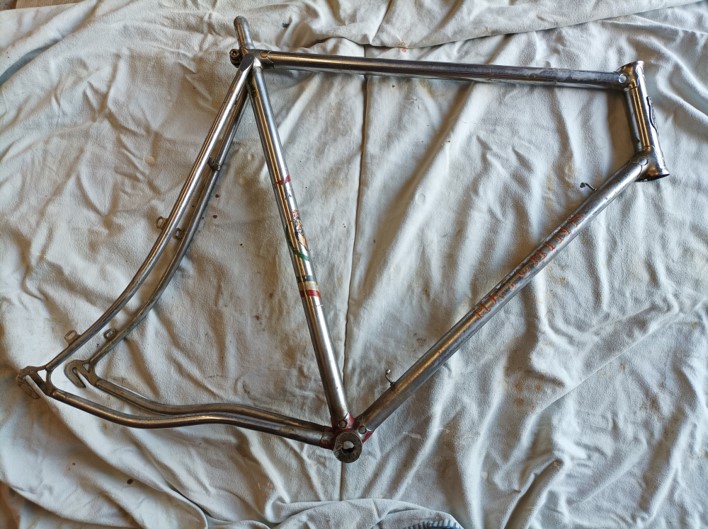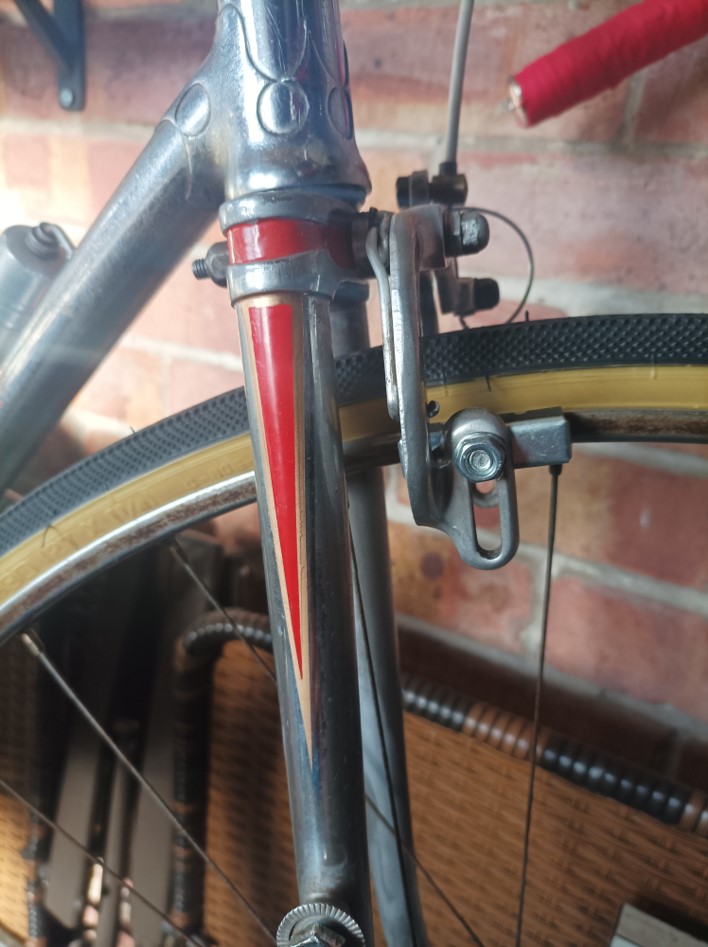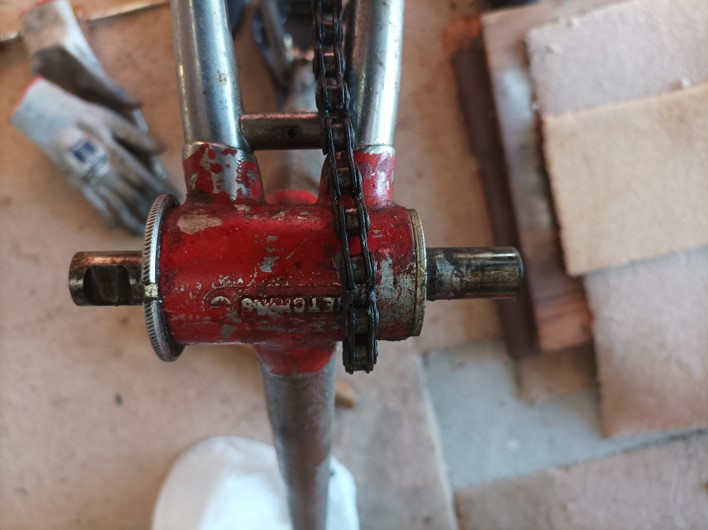Hetchins color schemes
1935 - 1959
I am often asked what color scheme would be appropriate for restoring a Hetchins. Period-correct transfers are well-known for each decade, but paint schemes less so. To remedy this, I shall be delving into the Hetchins photo archive, which contains literally tens of thousands of pictures, going back to 1935, and includes a number of original paint jobs.
This page covers the period 1935 - 1959. Of all the frames in the Hetchins Register, more frames survive from the 1950s than from any other decade; this is due to the high production levels during this decade. Many have been resprayed more than once since then, though a fair number have been documented in original livery. Very few frames survive from the 1930s or 40s in original livery. The photos on this page show, insofar as possible, frames in original (usually tatty) condition or accurately restored condition.
Available finishes during the 1930s included enamels and chrome. Few 1930s frames have been documented with original finishes intact; otherwise, for 1930s frames, we rely on period photographs and catalog descriptions.
Available finishes during the 1940s included enamels and chrome as before, with an expanded palette.
Period catalogs mention that frames were "bondarized." Bonderizing is a zinc phosphate coating carried out to the metal before paintwork, probably also coated on the inside of the tubes, to prevent rust.
The 1951 catalog listed "flamboyant on silver lustre" for the first time. Flamboyants involved several coats of translucent paint on top of a silver or gold base. I believe this technique was developed a few years before Hetchin offered it in his 1951 catalog. Flamboyants (candy-apple red, for example) have an appearance of depth which photographs do not depict; they have to be viewed in person, in direct sunlight, to be appreciated.
The 1951 catalog notes an interesting caveat regarding flamboyants:
"In the past, Hetchins were noted for their high-class chromium plating and enamelling. [which he out-sourced, see below for more on this]. Today, with the restriction on plating, and the ingredients necessary for first-class enamel paint and varnishes, leaves a lot to be desired. But we are the whole time endeavoring, even when a frame is finished plainly, to give the kind of high-class finishes we are associated with. We are able to undertake chromium plating but, while the nickel ban is on, chromium must needs be on copper."
The above text wants some unpacking. First, Hyman Hetchin out-sourced his chroming and painting operations. One corresppondant claims, from memory, that Hetchin's frame painting was done by Broma enamelling (later Relyon Broma) at Gallows corner, Romford, Essex (later East London). The company did enamelling for a lot of the London frame builders at the time. Reportedly, they finished in the late 1970s/early 1980s. Transfers and lug lining were done there by a gentlemen known to my correspondent only as Arthur; he kept a large stock of transfers. Other transfers (Hetchin's Coronation type) were found in the Hamstel Road shop safe when David Pullinger took over as manager in approx 1986. (The only other contents of the safe was a large collection of Playboy magazines. --now probably worth more than the Coronation transfers ! --Ed.)
Second, the "restriction" and "nickel ban" mentioned in Hetchin's 1951 catalog refer to (metal) rationining in Britain during and after the war years. Apparently this caused some difficulty in getting proper finishes, at least for a time. Metal was so scarce (for non-military applications) during the war years that getting castings for lugwork was difficult for cycle manufacturers, which led Claud Butler to develop fillet-brazed frames with bi-laminates (according to Ken Janes). Rationing in Britain was phased out starting in 1949 (clothing) and ended on 4 July 1954 (bacon was the last item to go!).
By 1956, the industry appears to have sorted the matter; Hetchin's catalog for 1956 states that "chromium plating is now guaranteed on nickel and we have now re-introduced flamboyants on polished nickel that are most pleasing in appearance and quality." [*]
|


Above: We start off with a post card reproduced from an early b&w photograph of the Anglo-Continental model. This model first appeared in the catalog for 1939, but examples are known from sales ledgers as early as 1937. The catalog described the color scheme as follows: "special continental colors [whatever those were], panelled and lined by hand, and international chevrons, chrome plated front and rear ends; head lugs chromed also at no extra charge."
Below: a modern respray based on the above color scheme; the frame dates from Nov. 1937.
|

Below: a model Brilliant No. 1 from 1937 in original livery. The catalog for 1935 described the color scheme as follows: "chrome all over or enamelled any color with chrome rear triangle, head and forks all over." Note also the painted spike extending down the fork blade from the crown.
|



Below: two examples of 1939 frames in original full-chrome, showing the painted spike on the fork blade.
|




Below: a 1939 Brilliant, original chrome, no lining.
Note that chrome is porous and will rust, as seen here.
|


Below: the same bike, now fully restored.
High-gloss black enamel, gold lug lining, no chrome.
|


Below: a renovated frame from 1936-7 with correct single-color enamel, full-chrome ht and head lugs, double-box lining.
|


Below: a 1939 Brilliant, modern respray, two-color enamel, double-box lining.
|




Below: a frame, about 1940, in possession of the first owner's family, probably with original livery showing faint traces of double-box lining.
|


Below: a 1947 Competition, verified as late as 2023 to be in original, unrestored, condition, featuring full-chrome and traces of original paint. Note the gold-lined red spike on the fork blade, and the painted bb shell (which was troublesome to polish to mirror-like shine when chromed).
|



Below: a 1951 Mag. Opus with spectacular gold-translucent finish over full chrome.
|



Below: very common for 1940s and 1950s frames: basic black with gold lined lugs.
|


Below: for those with thicker wallets: basic black with gold lined lugs and chrome. Note another chrome trouble spot: what to do with the topeyes and the seat binder bolt boss? Difficult to polish those areas.
|



Scores of Hetchins have been renovated to a similar standard.
Below: a renovated 1952 Nulli Sesundus in classic black & chrome w/gold lining.
|

Below: full chrome, unrestored from 1950. Chrome is porous, note pitting and rust from the inside (after 75 years!).
|





Below: examples of box lining from the early 1950s, original (unrestored). Box lining was much less often seen after this, but was occasionally seen for special orders from 2000 onwards.
|





By the mid 1950s, we begin to see a paint scheme which would become very common in later decades: main tubes and stays one solid color, ht a contrasting color, often (but not always) a colored panel on the st matching the ht, with bands above and below the central st panel.
Below: a 1957 Vade Mecum; farther below, 1957 Mag. Bonum, showing two-color paint schemes.
|



* Footnotes and references:
1. Metal rationing in the USA (aluminum [American spelling], tin, iron, nickel).
Click here. Joan Fontaine and Gary Cooper received plaster-cast Oscars in 1942.
Metal rationing in the UK (aluminium [Bri-ish], tin, iron, nickel) continued even after the war; private industrial use of metals was subordinated to an aggressive post-war re-armament programme, which caused a serious shortage of nickel and nickel-steels for motor vehicle and cycle manufacture into the early 1950s. Ending rationing was a serious bone of contention between Labour and Conservative politicians.
Click here.
2. War-time rationing in Britain.
Click here.
3. Hetchin's catalog for 1951.
Click here.
Hetchin's catalog for 1956.
Click here.
4. Chroming primer:
click here. There are two sorts of chroming: decorative and industrial (also called hard chroming). Decorative chroming is what is applied to bicycle frames: it gives a mirror-like surface, resistent to rust, but nonetheless porous and may rust or blister from underneath. Nickel or copper is layed down first, chromium on top.
5. Bondarizing:
click here.
The Editor wishes to thank the following email correspondents, who contributed to this article:
David Miller, Hetchins Lightweights
Ray Etherton
Bill Raczkowski, Secretary WAHCC
Garry Needham, Argos Racing Cycles, Bristol
Cally, V-CC
Alan, V-CC
Further research in progress through the V-CC, updates in due couse;
much appreciated to all.
Please use the Site Nav thingy at the right for paint schemes 1960-99, and 2000 to the present.
|
email:
















































